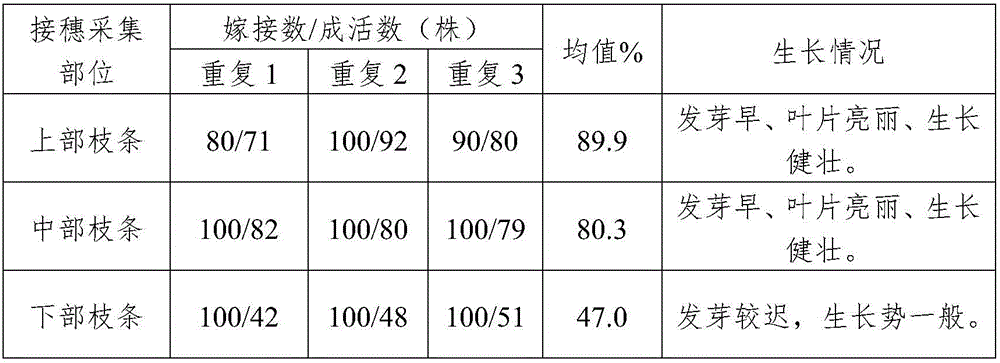Ancient phoebe zherman grafting, breeding and preserving method
A preservation method, the technology of Phoebe, which is applied in the field of plant biology, can solve the problems of branch aging, decline in flowering and fruiting ability, physiological age, etc.
- Summary
- Abstract
- Description
- Claims
- Application Information
AI Technical Summary
Problems solved by technology
Method used
Image
Examples
Embodiment 1
[0019] Different scion lengths of embodiment 1 carry out grafting test
[0020] Generally speaking, the shorter the length of the grafted scion, the better, and it is optimal to keep one full bud in most cases. After many pre-experiments, it was found that for the spikes collected from the ancient trees of Zhejiang Phoebe and Fujian Phoebe, it is almost impossible to graft them using conventional methods. For this reason, the impact of different lengths of scions on the survival rate was specifically discussed. However, as the length of the scion increases, under conventional management conditions, that is, after grafting, it is airtightly bandaged and placed under a normal shade shed for cultivation. The long branches will slowly die due to rapid water loss, while the short branches will slowly lose water. Difficult, the survival rate is not high. For this reason, the scion experiment with different lengths was carried out again after the follow-up management experiment was...
Embodiment 2
[0024] Survival rate of grafting of different parts of spikes in embodiment 2
[0025] As far as ancient trees are concerned, Zhejiang Nan and Fujian Nan are the same. As the age of the tree increases, its developmental age increases, and the growth potential of the tree decreases year by year, especially in the growth of branches and leaves. The purpose of this experiment is to choose where the branches can be grafted with a relatively satisfactory survival rate and high-quality seedlings.
[0026] In the test, the cuttings collected from the lower branches of ancient Phoebe (the most convenient to collect), the middle and the upper part of the tree crown were used for grafting experiments under the same conditions. The results are shown in Table 2.
[0027] Table 2 Grafting survival rate of branches in three parts of ancient Phoebe
[0028]
[0029] As shown in Table 2, the grafting survival rate of the upper branch of the crown is the highest, which is the same for the...
Embodiment 3
[0030] Embodiment 3 Grafting survival rate of different picking time
[0031] Generally speaking, grafting uses scion to benefit survival along with harvesting.
[0032] In this test, the stored ungerminated branches and the picked branches after sprouting were used for the test. According to the actual test results, the latter has very few surviving plants (see Table 3), and has no application value.
[0033] Table 3 Effects of different collection time of cuttings on the survival of ancient Phoebe grafted
[0034]
[0035]
PUM
 Login to View More
Login to View More Abstract
Description
Claims
Application Information
 Login to View More
Login to View More - R&D
- Intellectual Property
- Life Sciences
- Materials
- Tech Scout
- Unparalleled Data Quality
- Higher Quality Content
- 60% Fewer Hallucinations
Browse by: Latest US Patents, China's latest patents, Technical Efficacy Thesaurus, Application Domain, Technology Topic, Popular Technical Reports.
© 2025 PatSnap. All rights reserved.Legal|Privacy policy|Modern Slavery Act Transparency Statement|Sitemap|About US| Contact US: help@patsnap.com



